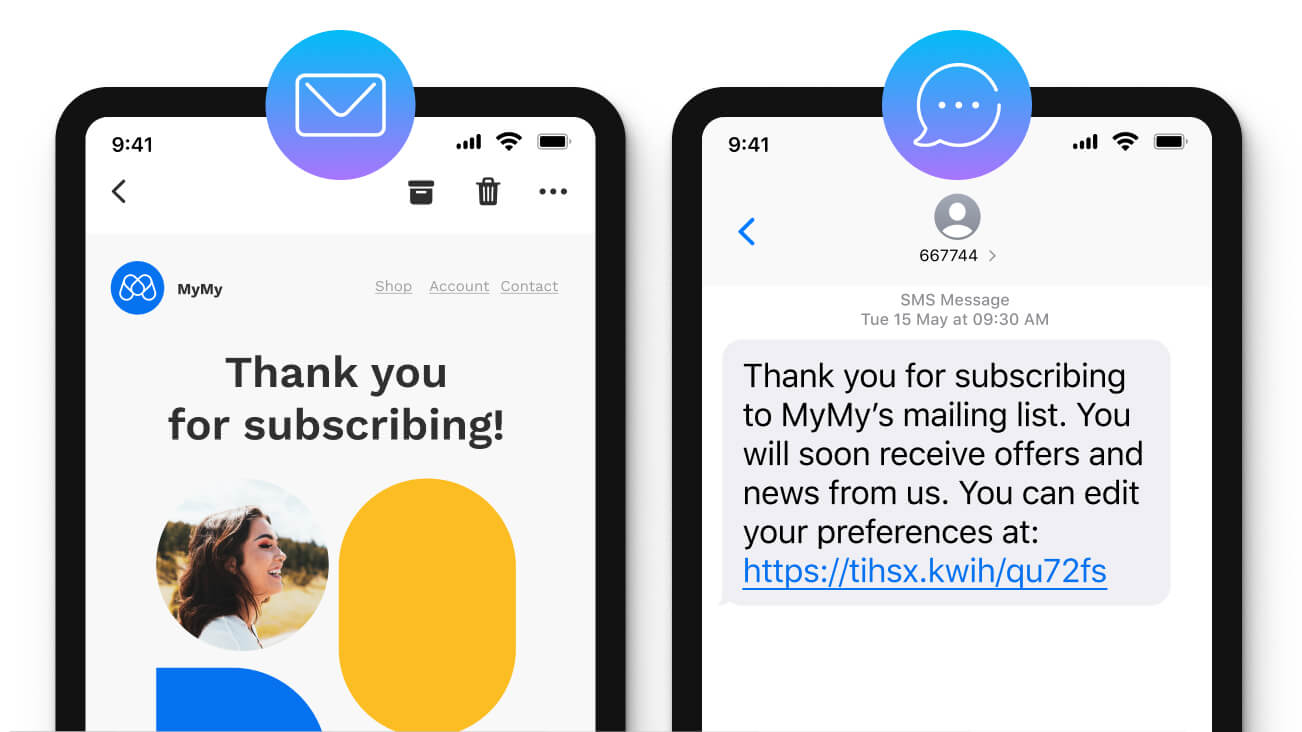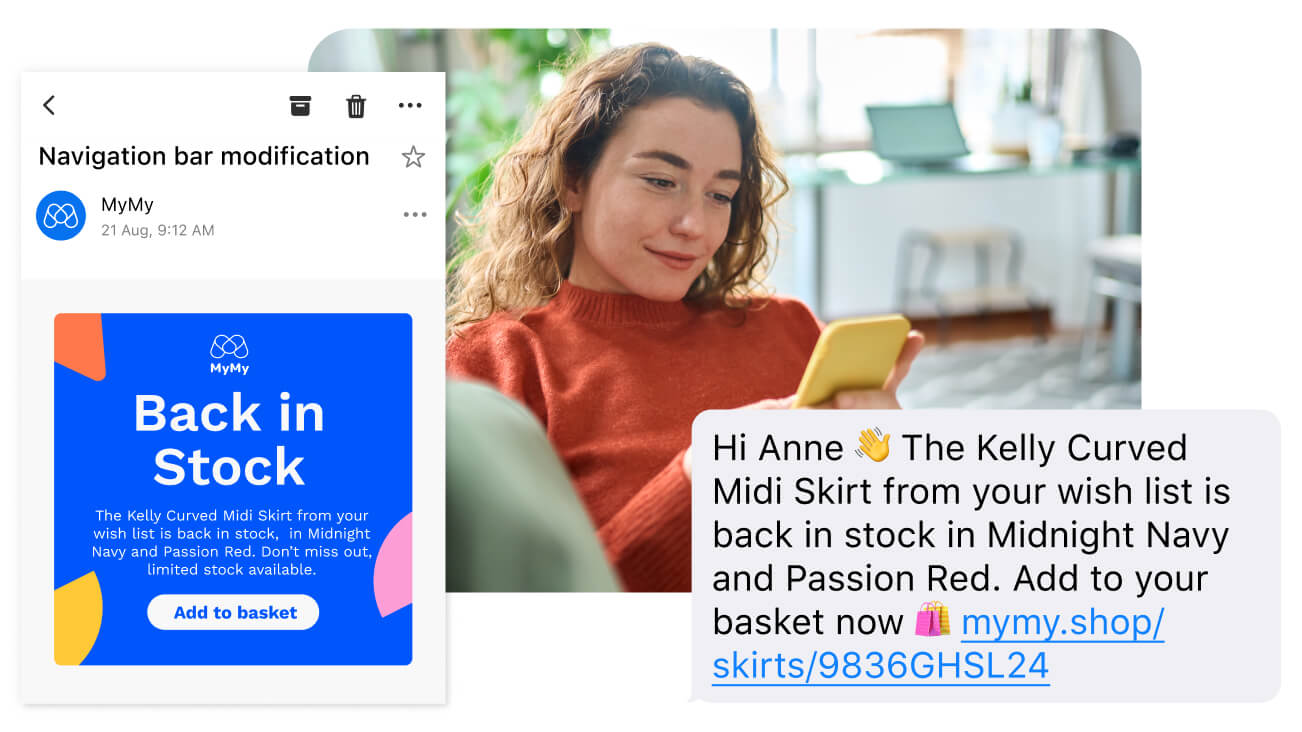How to blend email and SMS marketing for ultimate omnichannel success.
Email has a huge potential audience, but it can be hard to stand out in a crowded inbox. Here’s how you can combine email and SMS marketing to get better results.
Contents
It’s a typical morning. You open your email client and start clearing out the clutter in your inbox. Your eyes glaze over the dozen or so emails from retail chains you’ve visited as you hit the delete button. But then your phone vibrates in your pocket. You check it immediately to see a text from your favourite clothing store. And they’ve got a big sale on.
While this won’t apply to all consumers, many will place greater emphasis on text messages rather than emails.
Why is this? With over 347B emails sent every day, it’s a highly saturated channel—making it difficult to stand out from the crowd.
That’s why organizations across all industries are combining email with other messaging platforms to get the best of all worlds. One particularly strong companion to email communications is the equally historic SMS (short message service) text message.
Why exactly do these two channels pair so well together, and how can you blend them to deliver the very best campaign results? We can help answer these questions, and offer tips for omnichannel campaigns and run through real examples of successful user journeys across email and SMS.
And if you want even more guidance on delivering the very best SMS campaigns, take a look at our SMS marketing guide.
Email vs SMS: how do the two channels compare?
Like any communications platform, email and SMS offer advantages and disadvantages across a few key areas.
Format
SMS messages are limited to 160 characters and can only display text and links. This makes them concise, punchy and attention grabbing. However, emails can be longer and more versatile with custom formats, using different fonts, images and other rich media.

Delivery
SMS messages are typically delivered instantly, making them great for time-sensitive communications. And as they’re delivered using a mobile connection, your prospects can receive SMS messages wherever they are. Meanwhile, email delivery times can be variable, and requires internet connectivity which may not always be available. Making email less suitable for urgent, time sensitive messages.
Trust
0%
of emails are spam.
High proportion of unwarranted emails has reduced consumer trust in the platform with spam making up 45% of all emails sent globally. While SMS messages are used for spam, the rates are much lower, so prospects are more likely to pay attention to and open SMS messages.
Brands can further build trust in SMS by using branded text, showcasing their sender ID so the recipient knows the message is genuine.
Competition
With so many emails campaigns being sent and received every day, open rates are low and competition for attention is high. SMS inboxes tend to be less crowded, making it easier to stand out. In fact, SMS messages boast an impressive open rate of approximately 98%.
Summarizing the key differences between Email vs SMS
SMS | ||
|---|---|---|
Format | Text, images, GIFs, and embedded videos (depending recipient’s email client) | Text only |
Character limits | Unlimited | 160 characters, including spaces |
Open rates | 19% average | 98% average |
Click-through rates | 2-4% | Up to 19% |
Security | Unencrypted and stored on centralized servers | Encrypted end to end, stored on the customer’s device |
Delivery | Variable depending on email server and sender reputation | Near instant |
SMS
Compatible on all devices
Supports all kinds of rich media
Can be any length
Hard to stand out in crowded inboxes
Can be distrusted by users
Delivered instantly and reliably
A less saturated communications channel
Generally more trusted by users
Limited to 160 characters
No multimedia support
Combine email and SMS for maximum engagement
SMS messages boast quick delivery and compelling open rates but are limited in length and the types of media you can use. Meanwhile, email is more flexible, but may get lost in crowded inboxes. Together, both formats can support and complement each other to deliver a powerful omnichannel communications strategy.
For example, a retailer will likely lead with email to promote new items with images or embedded video. But after a customer has made a purchase, SMS will be the better format to send delivery notifications.
Another example is using emails to alert customers to a pending sale and showcase multiple items that will be discounted. To avoid the risk of this email not being opened, a follow up SMS message can be sent to the customer with a discount code to promote a sense of urgency and improve conversion rates.

By combining the two channels in this way, email offers deeper context and multimedia potential, while SMS supports with rapid delivery and its much higher open rates. With the two together, you can use each channel depending on customer preferences and create seamless touchpoints that engage and delight customers.
Examples of combined email and SMS marketing campaigns
Post-sale follow-up and reminders
SMS: Send an SMS notification of the purchase along with delivery updates.
Email: Follow up with product recommendations in an email based on the customer’s recent purchase.
Security notifications
SMS: Send two-factor authentication (2FA) codes.
Email: Help customers reset their passwords if needed.
Customer feedback surveys
Email: Make initial contact, using visuals to draw recipients in and offering to take part in the survey.
SMS: Follow up with a nudge to improve survey completion rates.
Event invitations
Email: Send out initial marketing messages, showcase speakers and event content in a visual way, and offer an easy booking link.
SMS: Drum up a sense of urgency and remind potential attendees about event timings or booking deadlines.
How one telco company makes the most of email and SMS
Using Webex Connect, SMARTY, a rapidly growing UK-based mobile operator, has unified SMS, email, and RCS (rich communication service) communications to deliver two new customer journeys:
1. With a combined comms platform linked to its Trustpilot reviews program, SMARTY can prompt customers to easily leave reviews via RCS messages.
2. When SMARTY gets a PAC code request from customers looking to leave the network, it can automatically send an RCS and SMS retention campaign to try and change the customer’s mind.
Since deploying these omnichannel use cases through Webex Connect, SMARTY has improved engagement by 100% compared to when it was using email alone. Learn more about SMARTY’s omnichannel approach.
If you’re ready to boost campaign results and customer engagement, get in touch and speak to one of our specialists today.
Tips to get the most out of email and SMS marketing strategies
-
Get the delivery cadence right
While SMS and email can both be used to send messages to your customers and prospects, the two mediums come with different cultural expectations. While most of us are used to receiving dozens of emails a day, text messages are a less regular occurrence. As a result, your audience will have less tolerance for receiving lots of SMS messages, particularly in a short timeframe.
-
Play to each platform’s strengths
While it may be tempting to copy campaign text across emails and SMS to save time, this will stop you from getting the most out of each medium. Emails can take longer form copy as you can use images and white space to break up chunks of text, while SMS messages need to be shorter and get to the point quickly.
-
A/B test across the two channels
While it’s common practice to trial different email designs and copy through A/B testing, it’s important to experiment in the same way with SMS messages. You can test different messages, lengths, and delivery cadences to find the sweet spot. And don’t forget to test across the two messaging channels too. Trial different types of messages as email and SMS, and see which gets the best results to truly learn where each platform works.
-
Integrate data silos
Just as you’ll segment your mailing lists based on customer preferences and demographics, you’ll want to bring this same data-driven approach to your SMS communications. That means sharing data effectively across teams and mediums, and making sure you’re using the same data to inform all marketing and communication channels.
-
Make the benefits of each channel clear
To make the most of email and SMS together, you’ll need to ensure customers and prospects offer consent to receive communications across both channels. To do this, make the benefits of signing up for each channel clear. For example, you might focus on the exclusive offers or discounts customers will receive when they join your mailing list, or the frequent shipping updates they can receive if they add a phone number to their user account.
-
Get the right platform to manage your communications
Trying to manage A/B tests and segmentation across platforms is tough. But it becomes almost impossible if you’re manually orchestrating delivery. Communications Platform as a Service (CPaaS) solutions are an excellent way to automate and simplify email and SMS message delivery, and can help you manage all platforms through a single pane of glass.
Create stand-out customer journeys with Webex Connect
Webex Connect is an enterprise CPaaS platform that helps organizations:
Integrate email, SMS, RCS, and other common channels into an omnichannel strategy.
Automate customer journeys and deliver rich customer touchpoints.
Optimize cross-channel interactions with granular reporting tools.
Get in touch today to discuss how SMS marketing and email works with Webex Connect. You can also sign up for a free solution demo here.